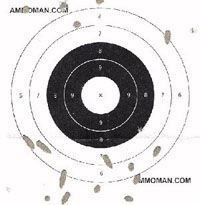Introduction
Rounds in flight spin for stability because of the rifling on the inside of the barrel. Depending on how much they spin, they are more or less stable in their flight and therefore more or less accurate. The earliest AR15s from the early 1960s had a twist rate of 1 complete twist every 14", or 1:14. This was increased to a twist rate of 1 turn in 12" for the M16, XM16E1, M16A1, and later rifles and carbines. The current M16A2s and up and the M4 carbines have a much faster twist rate, 1 turn in 7". The reason for the 1:7 twist is mainly to stabilize the M856 tracer bullet, which is much longer than other bullets. You will recall from above that the M856 was designed to provide 800 meters of trace out of the SAW.
While the slow 1 in 12" twist is adequate to stabilize the 55 grain M193, it will not stabilize the 62 grain M855. As a result, the newer M855 ammo will group 1-2 feet at 100 yards, with bullets flying through the air sideways, instead of shooting to about 2" at 100 yards, like military ammo should.
All this has some ramifications for ammunition selection depending on your rifle's rate of twist.
You can also overspin projectiles and cause overstability. This results in the not-so-desirable condition that keeps the nose of the round pointed high, as illustrated below:

You can also spin them so hard they fly apart. That's rare, but it happens if you are dealing with very tight twists and very high velocities. When fired at 3200 fps in a 1-in-7 twist rifle, a round is rotating at over 300,000 rpm when it leaves the muzzle. Light, thin-jacketed varmint bullets (i.e., 40gr Hornady TNT or Federal Blitz bullets) often can't take that much spin and will pull themselves apart.
FACTS:
- Generally you want a gyroscopic stability factor (Sg) of 1.3 or greater in a given round, about the low end for normal shooting. You get this on the larger M855 round with a 1 in 9" twist. By comparison a 1 in 10" twist will keep that M855 round down to about 1.2- not enough if it starts to get cold. Really you want stability to be between 1.5 and 2.0- a 1 in 8" twist on a M855 round. In actuality a 9" twist is a bit better for accuracy as it doesn't spin up non-balanced bullets too fast causing them to wobble in flight. If you have match rounds, well balanced and tested, you don't really have to worry about overtwisting until you hit 5.0 or so.

The result of unstabilized bullets: A 1 in 12" FN-FNC firing M855 at 100 yards. (Note the profiles cut out of the target)
Math and Physics:
A spin-stabilized projectile is said to be gyroscopically stable, if, in the presence of a yaw angle, it responds to an external wind force with the general motion of nutation and precession. In this case the longitudinal axis of the bullet moves into a direction perpendicular to the direction of the wind force. It can be shown by a mathematical treatment that this condition is fulfilled, if the gyroscopic stability factor (SG) exceeds unity. This demand is called the gyroscopic stability condition. A bullet can be made gyroscopically stable by sufficiently spinning it. As the spin rate decreases more slowly than the velocity, the gyroscopic stability factor, at least close to the muzzle, continuously increases. Thus, if a bullet is gyroscopically stable at the muzzle, it will be gyroscopically stable for the rest of its flight.
 Win a FREE Membership!
Win a FREE Membership!